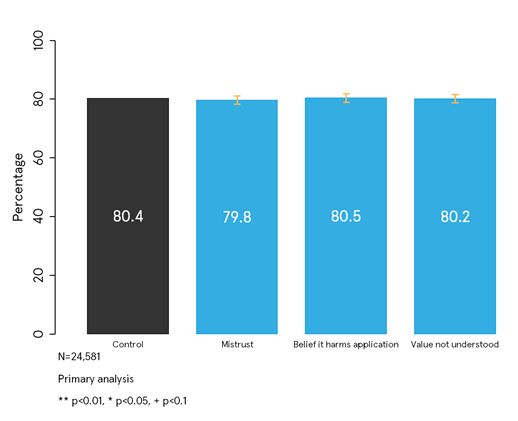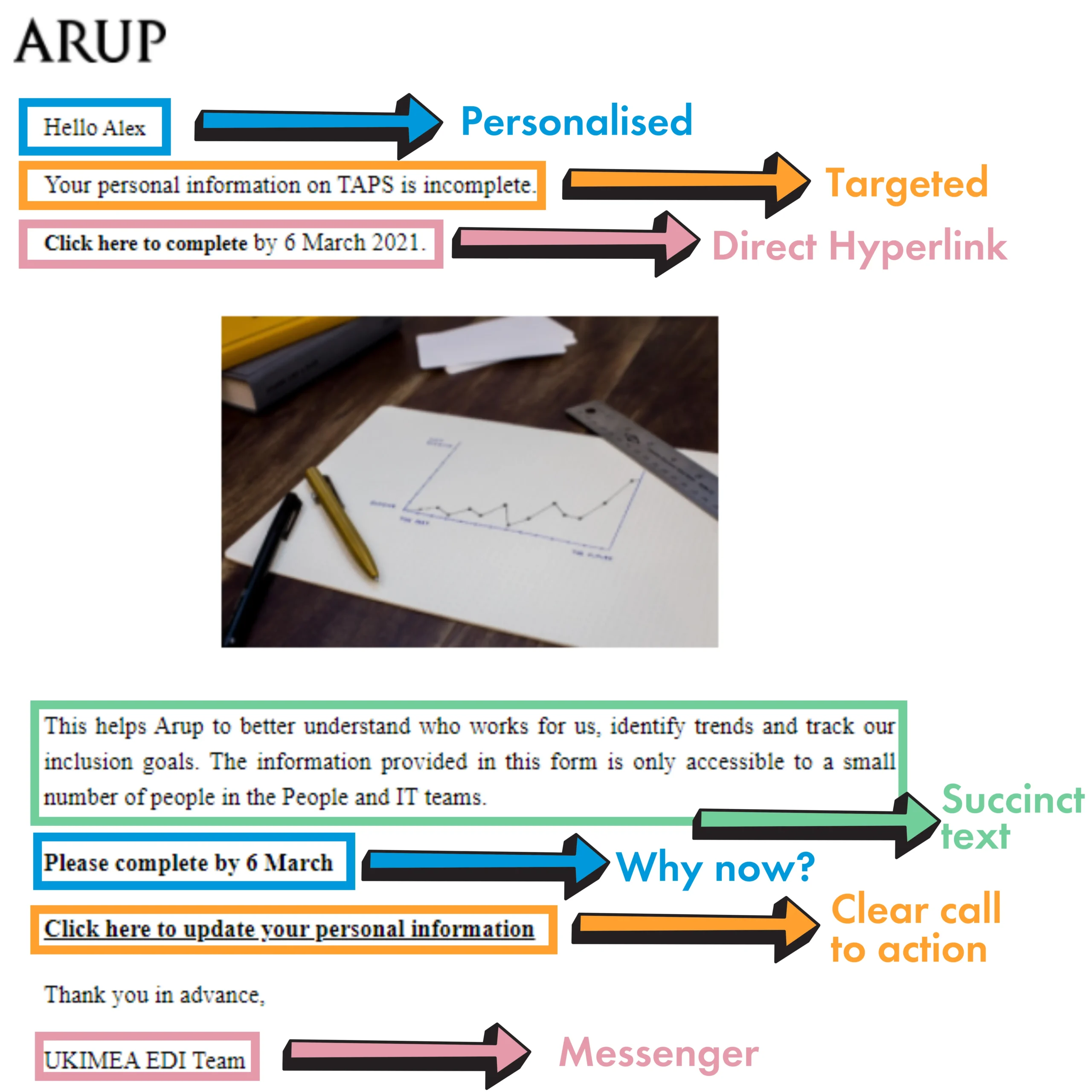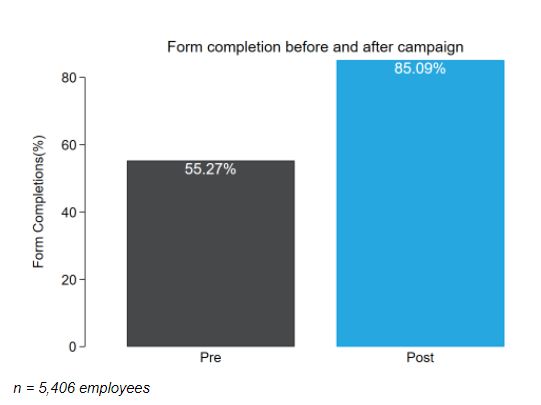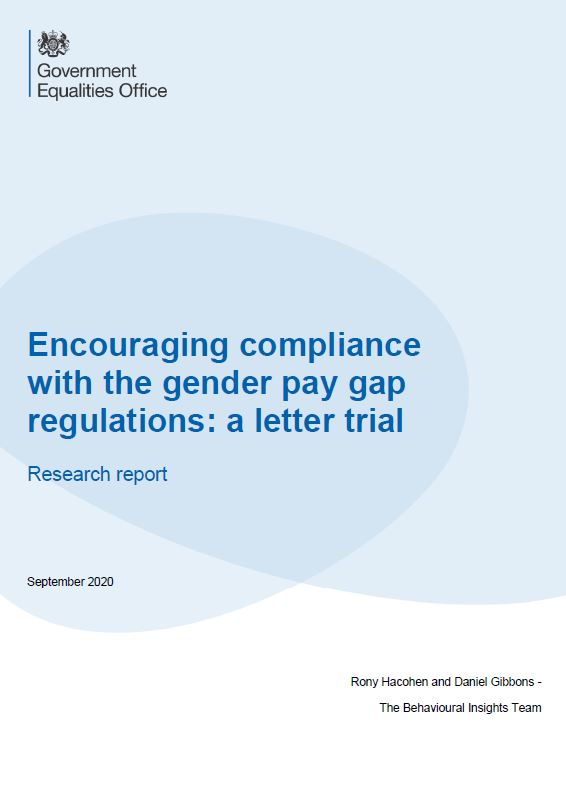Data is critical for progressing equality, diversity and inclusion (EDI) goals. Transparency and accountability are both foundational for improving EDI and these cannot be achieved without data regarding both employee characteristics and workplace outcomes. While gender pay gap reporting has been shown to reduce gender inequality, many organisations in the UK are not able to accurately calculate their pay gaps for wider characteristics such as race & ethnicity, disability, sexuality or socioeconomic status, due to poor data coverage.
Improving data coverage relies on both employers routinely collecting and storing data, and employees voluntarily sharing their data. There is currently very little robust evidence regarding the best way to improve data collection. Current ‘best practice’ guidance tends to focus on employee attitudes towards sharing data. While attitudes certainly have a role to play, could focusing too much on them get in the way of more effective approaches?
Increasing demographic data disclosure during recruitment
We worked with the recruitment platform Applied, which aims to remove bias from the hiring process, to understand what works to increase voluntary disclosure, particularly for sexual orientation. While Applied already collected data for a range of characteristics, including gender, race & ethnicity, disability and socioeconomic status, they were introducing a question on sexual orientation for the first time. This work was funded by the Government Equalities Office.
There is little to no rigorous experimental research testing what works to increase voluntary disclosure. Existing evidence almost exclusively focuses on attitudes: especially trust in data privacy, perceived value of disclosure, and fear of negative consequences. Other factors identified in the literature include question content and structure, and response options. We held a workshop with representatives from the Government Equalities Office’s LGBT policy team and Applied staff to co-design the intervention messages based on these attitudes.
We carried out a randomised controlled trial to test the impact of different introductory messages to the equal opportunities form on applicants’ disclosure of personal information. The trial involved around 25,000 applicants to all UK vacancies on the Applied platform between September and December 2019. The introductory messages tested each aimed to address one of the three key attitudes explored in the co-design workshop:

We compared disclosure outcomes for each of these messages with Applied’s existing introductory message as the control.
Designing solutions primarily around attitudes may be ineffective for disclosure
None of the intervention statements increased disclosure for sexual orientation or any other demographic characteristics on the form. The results may suggest that applicants do not pay attention to the introductory text, that the already high disclosure rate in this recruitment context could not increase further, or that other behavioural barriers are more important. Read the full report here.

Other behavioural barriers may play a greater role in disclosure
Disclosure rates are often lower for existing staff in an organisation than among applicants during the recruitment process. At Arup, an engineering consultancy, only around 55% of their staff had fully completed their demographic form, but Arup’s ambition was to reach 80%.
We worked with Arup to understand whether tackling other behavioural barriers would be more effective than targeting attitudes. In interviews with Arup’s staff, we came across variations of the three common attitudes identified in our previous trial, in particular, the mistaken concern that line managers would have access to personal data.
However, the relationship between attitudes and behaviour is less than straightforward. For example, 72% of people who disclosed their disability at their most recent job rated concern about being fired as ‘very important’ to disclosure, while 50% of people who did not disclose in a survey believed that diversity monitoring was important.
Meanwhile, we also heard from staff about behavioural barriers such as not realising they had not disclosed, confusion about how to complete the form, and feeling they did not have enough time for it. Previous communications Arup sent to staff about disclosing were several pages long and did not make the relevant action obvious.

Succinct communications are more transparent
We designed an email that made it as easy as possible to identify how to disclose and whether this was a relevant action for that employee. Emails were only sent to people who had not completed their form to make it clear who could take action, and accessing the form was made easy with a direct hyperlink.
The email body focused on summarising the key messages that people cared about most in two sentences: the purpose of collecting data and who had access to it. Organisations are often tempted to flood staff with information in an attempt to be transparent, when in reality it can have the opposite effect by obfuscating key information and overwhelming recipients, a bit like product terms & conditions.
For the small minority who like to read further detail about how the data are used and stored, this was available in a hyperlinked webpage. We also made adjustments to the question content and response categories in line with ONS guidelines, which have been heavily user-tested.
Removing frictions had a positive impact
We carried out the initiative in March 2021 with Arup’s staff. The percentage of staff with fully completed forms increased from 55% to 85%, which involved two-thirds of the target audience completing their form and exceeded Arup’s original target. This provided Arup with enough data to begin to measure and track their inclusion goals with a much greater degree of confidence.

We anticipated that many staff would be unlikely to take immediate action unless it was very convenient when they received the email. We therefore deliberately sent follow-up reminders. While the first email led to the highest proportion of the target audience completing their form (37%), sending three follow-up reminders almost doubled this (67%). Staff could unsubscribe from receiving reminder emails, although fewer than 1% did. This shows the value of following up after the initial communication.
Recommendations for employers
- Involve staff. Speak to staff to understand their greatest concerns around disclosure, while understanding how far they act as a blocker to behaviour.
- Be clear and transparent. Prioritise and address the greatest concerns staff have in the most succinct way possible to achieve genuine transparency.
- Remove frictions. Make the process of disclosure as easy as possible to reduce the burden on staff. Work with employees to identify key obstacles in the process.
- Use the data to improve EDI. Identify key causes of inequality in the organisation and use this information to target and prioritise EDI initiatives, and evaluate how effective they have been.






